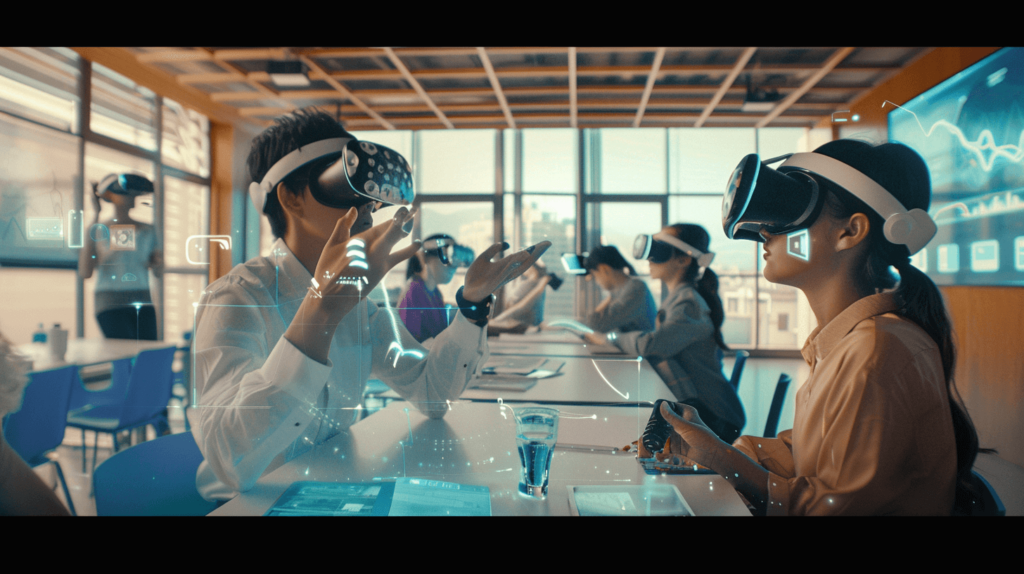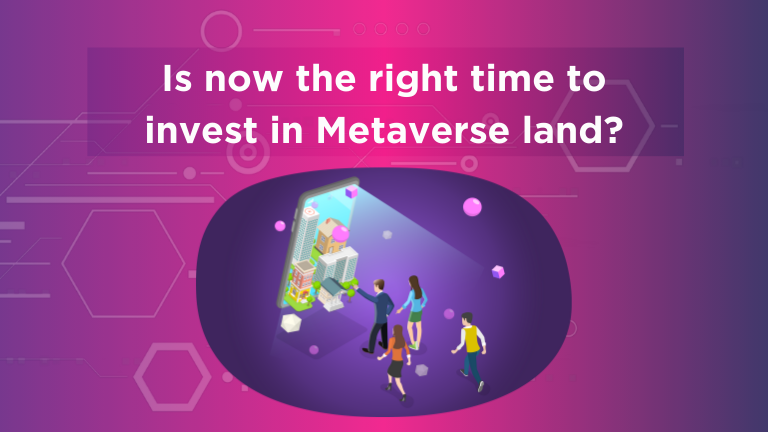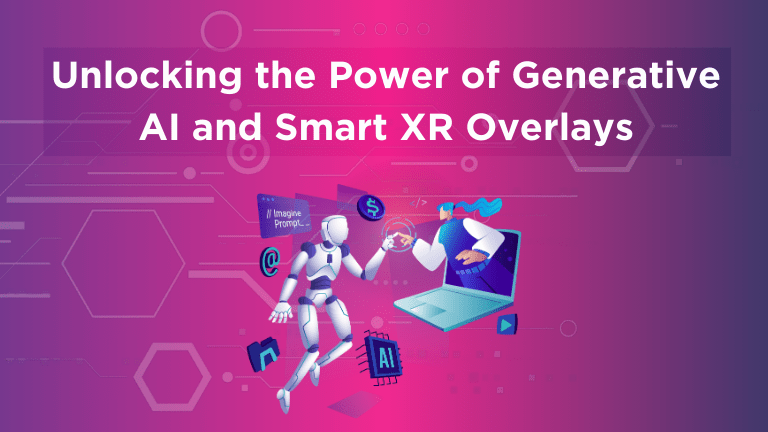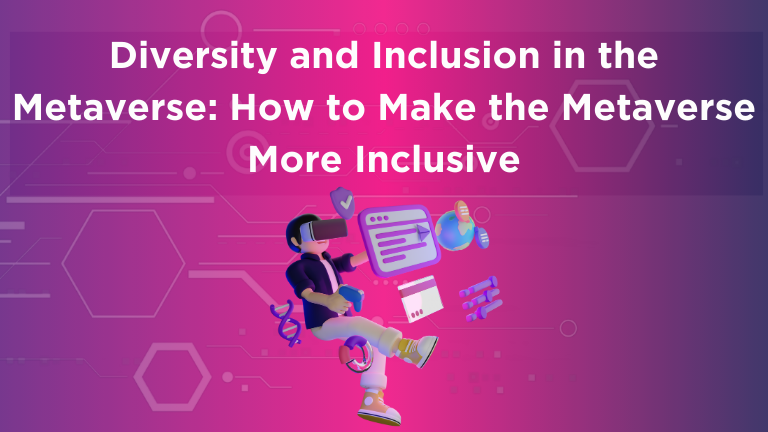The GenXR Revolution: How AI and XR are shaping the future
In recent years, the tech world has seen a notable shift in focus. While extended reality (XR) and the metaverse were once the catchphrases exciting everyone with promises of immense financial opportunities through immersive experiences, artificial intelligence (AI) has now taken centre stage. The swift progress of generative AI and tools like ChatGPT has captured the attention of industries worldwide.
However, this shift doesn’t make XR and the metaverse obsolete. As we explore both AI and XR more deeply, a symbiotic relationship between these technologies becomes increasingly clear. Even AI giants like Nvidia and Meta are putting substantial resources into ways to join artificial intelligence with the metaverse.
This meeting of AI and XR is poised to change businesses, alter the recruitment scene, and modify how we work. Let’s examine the intricate connection between these technologies and what it means for the future.
The Synergy of AI and XR: A Detailed Look
Artificial Intelligence, at its heart, is about creating computer systems that can carry out tasks that typically require human intelligence. These systems can mimic human processes such as learning, reasoning, and problem-solving. Extended Reality, on the other hand, includes immersive technologies like augmented, virtual, and mixed reality.
The union of AI and XR isn’t new. In fact, several types of AI have been influencing and improving XR experiences for years:
- Computer Vision: This AI technology allows computers to extract and understand data from visuals. In XR, computer vision is essential for recognising and understanding elements in the environment, enabling spatial computing experiences. It ensures the correct positioning of content, allows user interaction and helps navigate in XR environments. Advanced applications like Varjo Teleport use computer vision, machine learning, and image capture to create detailed virtual spaces.
- Generative AI (Gen AI) and Large Language Models (LLMs): Fuelled by vast amounts of data, generative AI can create assets ranging from 3D visuals to videos and even code for XR applications based on simple prompts. When combined with conversational AI, it opens up possibilities for creating more dynamic and interactive non-playable characters (NPCs) in XR experiences.
- Machine Learning and Deep Learning: These AI subsets allow systems to learn from data and adapt over time. In XR, machine learning enables applications to become more efficient and responsive to user preferences. Deep learning takes this further by analysing complex patterns and connections, allowing for more sophisticated predictive modelling in XR scenarios.
Transformative Use Cases for AI and XR Collaboration
The integration of AI and XR is opening up exciting possibilities across various industries. Let’s explore some of the most impactful use cases:
Changing Content Development: One of the most significant opportunities at the intersection of AI and XR lies in content creation. Developing content for XR experiences has traditionally been time-consuming and complex. Generative AI is altering this scene by speeding up asset development, allowing creators to design 2D and 3D illustrations, build virtual worlds, and even produce code for characters with unprecedented speed and ease.
Tools like Snap’s generative AI for Lenses are making content creation more accessible, enabling even those without advanced development skills to create immersive experiences. This acceleration in content production is paving the way for more companies to invest in metaverse applications across various platforms, from Meta’s ecosystem to Apple’s Vision OS.
Improving Device Creation and Performance: AI’s impact extends beyond software to hardware development in the XR space. Machine learning and deep learning models can process vast amounts of data about user habits, preferences, and design impacts, helping create more ergonomic, lightweight, and efficient XR devices.
AI is already enhancing the performance of XR hardware and reducing computational demands. For instance, AI-powered foveated rendering allows devices to concentrate rendering resources on the area of display the user is focusing on, significantly reducing bandwidth and energy requirements.
AI solutions can also personalise the user experience by adjusting factors like lighting and sound based on eye tracking and scanning techniques. Apple’s use of AI in creating customised Vision Pro headsets for individual users is a prime example of this application.
Enhancing User Engagement and Business Insights
Crafting Unique Customer Experiences: Both AI and XR are changing customer experience landscapes. In XR environments, AI-powered virtual assistants can guide customers through onboarding processes, demonstrate products, and offer real-time troubleshooting advice. These tools can also leverage customer data to make personalised product recommendations.
AI solutions in XR environments also offer powerful analytical capabilities. By tracking eye movements, gestures, and sentiments, they can provide valuable insights to businesses about product engagement and customer perceptions.
AI can also improve accessibility and personalisation in XR experiences by automatically translating content, creating closed captions, and adapting experiences to individual user needs.
Revolutionising Learning and Development
Improving Skill Development and Training: The combination of AI and XR is changing education and training. XR has already shown impressive results in educational settings, with studies indicating that VR learners acquire soft skills up to four times faster than traditional learners.

When AI is integrated into XR training environments, it opens up possibilities for highly personalised and adaptive learning experiences. AI coaches can provide real-time feedback and guidance based on a student’s performance, create tailored content based on individual interests, and adapt training strategies to suit different learning styles.
This powerful combination not only enhances formal education but also changes professional development and upskilling in the business world.
Boosting Data Generation and Analysis Both AI and XR rely heavily on data, and their combination creates a powerful data ecosystem. Generative AI tools can create synthetic data necessary for developing more advanced AI tools and XR applications. Conversely, XR solutions can generate rich, multidimensional data for AI tools to analyse and learn from.
Gartner predicts that by the end of 2024, 60% of the data necessary to create AI solutions will be synthetically generated. XR tools that allow developers to create new visual assets, soundscapes, and other elements will play a key role in generating this synthetic data.
XR devices excel at collecting valuable user data, from eye movements and gestures to biometric information like heart rate. This wealth of data can fuel more sophisticated AI models, creating a virtuous cycle of improvement in both AI and XR technologies.
Addressing the Challenges of AI and XR Integration
While the potential benefits of combining AI and XR are immense, this technological convergence also presents several challenges:
Data Security and Privacy: XR devices collect vast amounts of sensitive and biometric data, which must be protected. Similarly, AI solutions rely on huge volumes of data that need to be safeguarded to comply with regulations. As these technologies become more integrated, ensuring data security and privacy will become increasingly complex.
Currently, there are limited regulations specifically governing data management in AI and XR. However, as these technologies evolve and become more prevalent, we can expect stricter standards to emerge, impacting how AI and XR solutions are developed and implemented.
Skill Shortages: Both the XR and AI fields are facing significant skill shortages. There’s a high demand for professionals who can effectively create hardware and software for XR, and the same is true for AI specialists. The shortage of talent with expertise in both areas is even more acute.
To address this challenge, businesses will need to adopt strategic approaches to talent acquisition and development. This may involve partnering with specialised recruitment firms like Four Point Zero and investing in upskilling and training existing teams.
Implementation: Costs and Complexity Designing, implementing, and running AI-powered XR systems can be expensive and complex. These technologies often require significant bandwidth and computing resources, which can be a barrier for many organisations.
However, the industry is making progress to address these challenges. One such advancement is the development of intelligent chips that minimise the processing power required by XR solutions. The rise of edge and cloud computing solutions that offload some of the processing power required by XR devices may lead to greater accessibility for AI and XR solutions in the future.
Looking to the Future: The Evolving Scene of AI and XR
As we look ahead, it’s clear that AI and XR are not competing technologies but complementary forces that will continue to shape our digital future. Their integration will change content development, training methodologies, customer experiences, and countless other aspects of our personal and professional lives.
The combination of AI and XR is ushering in a new era of digital immersion and innovation. For businesses and professionals in the XR industry, staying ahead of this curve will be essential. This means not only keeping up with the latest developments but also actively seeking out and nurturing talent that can bridge the gap between AI and XR.
As these technologies continue to evolve and converge, we can expect to see even more groundbreaking applications and use cases emerge. From more intelligent and responsive virtual environments to highly personalised and adaptive XR experiences, the possibilities are truly exciting.
For those looking to be at the forefront of this technological shift, now is the time to start building your AI and XR capabilities. Whether you’re seeking to develop new tools, create innovative applications, or build immersive ecosystems, having the right expertise on your team will be essential.




